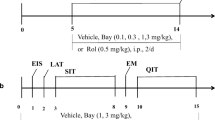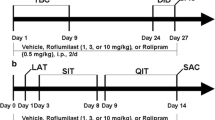Abstract
Rationale
Results from clinical studies have shown that topiramate effectively reduces alcohol consumption in a population of heavy-drinking alcohol-dependent humans.
Objectives
We undertook this preclinical study in order to establish topiramate’s efficacy in a rodent model and to determine whether topiramate’s efficacy may vary with level of drinking and/or genetic background.
Methods
The effects of acutely administered topiramate (0, 5, and 10 mg/kg) on ethanol consumption were examined in a large group of ethanol-preferring (P) rats (N = 20) in order to assess the relationship between level of consumption and treatment effect using a two-bottle free-choice paradigm (10% ethanol versus water). We also evaluated the effects of topiramate in two groups of Wistar rats that were given access to ethanol under either the standard two-bottle free-choice paradigm or under conditions that are known to produce higher levels of daily ethanol consumption (i.e. three-bottle free choice).
Results
Topiramate treatment produced a modest, but persistent (average of 5 days), reduction in ethanol consumption in P rats, and this effect did not vary with level of consumption. Topiramate did not affect ethanol consumption in either group of Wistar rats.
Conclusions
The results from this study establish in a rodent model that topiramate effectively and persistently reduces ethanol consumption and suggests that its efficacy may depend on genetic vulnerability but not level of drinking.



Similar content being viewed by others
References
Cagetti E, Pinna G, Guidotti A, Baicy K, Olsen RW (2004) Chronic intermittent ethanol (CIE) administration in rats decreases levels of neurosteroids in hippocampus, accompanied by altered behavioral responses to neurosteroids and memory function. Neuropharmacology 46:570–579
Chen YC, Holmes A (2009) Effects of topiramate and other anti-glutamatergic drugs on the acute intoxicating actions of ethanol in mice: modulation by genetic strain and stress. Neuropsychopharmacology 34:1454–1466
Easterling DE, Zakszewski T, Moyer MD, Margul BL, Marriott TB, Nayak RK (1988) Plasma pharmacokinetics of topiramate, a new anticonvulsant, in humans. Epilepsia 29:662
Gabriel KI, Cunningham CL (2005) Effects of topiramate on ethanol and saccharin consumption and preferences in C57BL/6J mice. Alcohol Clin Exp Res 29:75–80
Hargreaves GA, McGregor IS (2007) Topiramate moderately reduces the motivation to consume alcohol and has a marked antidepressant effect in rats. Alcohol Clin Exp Res 31:1900–1907
Hölter SM, Engelmann M, Kirschke C, Liebsch G, Landgraf R, Spanagel R (1998) Long-term ethanol self-administration with repeated ethanol deprivation episodes changes ethanol drinking pattern and increases anxiety-related behaviour during ethanol deprivation in rats. Behav Pharmacol 9:41–48
Johnson BA, Ait-Daoud N, Bowden CL, DiClemente CC, Roache JD, Lawson K, Javors MA, Ma JZ (2003) Oral topiramate for treatment of alcohol dependence: a randomised controlled trial. Lancet 361:1677–1685
Johnson BA, Rosenthal N, Capece JA, Wiegand F, Mao L, Beyers K, McKay A, Ait-Daoud N, Addolorato G, Anton RF, Ciraulo DA, Kranzler HR, Mann K, O'Malley SS, Swift RM, Topiramate for Alcoholism Advisory Board, Topiramate for Alcoholism Study Group (2008) Improvement of physical health and quality of life of alcohol-dependent individuals with topiramate treatment. Arch Intern Med 168:1188–1199
Johnson BA, Rosenthal N, Capece JA, Wiegand F, Mao L, Beyers K, McKay A, Ait-Daoud N, Anton RF, Ciraulo DA, Kranzler HR, Mann K, O'Malley SS, Swift RM, Topiramate for Alcoholism Advisory Board, Topiramate for Alcoholism Study Group (2007) Topiramate for treating alcohol dependence: a randomized controlled trial. JAMA 298:1641–1651
Knapp CM, Mercado M, Markley TL, Crosby S, Ciraulo DA, Kornetsky C (2007) Zonisamide decreases ethanol intake in rats and mice. Pharmacol Biochem Behav 87:65–72
Lê A, Shaham Y (2002) Neurobiology of relapse to alcohol in rats. Pharmacol Ther 94:137–156
Lê AD, Kiianmaa K, Cunningham CL, Engel JA, Ericson M, Söderpalm B, Koob GF, Roberts AJ, Weiss F, Hyttiä P, Janhunen S, Mikkola J, Bäckström P, Ponomarev I, Crabbe JC (2001) Neurobiological processes in alcohol addiction. Alcohol Clin Exp Res 25:144S–151S
McBride WJ, Chernet E, Russell RN, Wong DT, Guan XM, Lumeng L, Li TK (1997) Regional CNS densities of monoamine receptors in alcohol-naive alcohol-preferring P and -nonpreferring NP rats. Alcohol 14:141–148
McBride WJ, Murphy JM, Lumeng L, Li TK (1990) Serotonin, dopamine and GABA involvement in alcohol drinking of selectively bred rats. Alcohol 7:199–205
Morzorati SL (1998) VTA dopamine neuron activity distinguishes alcohol-preferring (P) rats from Wistar rats. Alcohol Clin Exp Res 22:854–857
Nguyen SA, Malcolm R, Middaugh LD (2007) Topiramate reduces ethanol consumption by C57BL/6 mice. Synapse 61:150–156
Rodd ZA, Bell RL, Sable HJ, Murphy JM, McBride WJ (2004) Recent advances in animal models of alcohol craving and relapse. Pharmacol Biochem Behav 79:439–450
Samson HH, Tolliver GA, Pfeffer AO, Sadeghi K, Haraguchi M (1988) Relation of ethanol self-administration to feeding and drinking in a nonrestricted access situation in rats initiated to self-administer ethanol using the sucrose-fading technique. Alcohol 5:375–385
Wolffgramm J, Heyne A (1995) From controlled drug intake to loss of control: the irreversible development of drug addiction in the rat. Behav Brain Res 70:77–94
Acknowledgment of funding and grants
This project was supported by funding from the Department of Psychiatry and Neurobehavioral Sciences at the University of Virginia in Charlottesville, Virginia. The P rats for this study were provided by the Indiana Alcohol Research Center, which is funded by grant 5P50AA007611-159005 from the National Institute on Alcohol Abuse and Alcoholism.
We thank Robert H. Cormier, Jr., BA, for his assistance with manuscript preparation, and Colin Bond for his technical assistance.
Declaration
The experiments described herein comply with the current laws of the United States of America.
Conflicts of interest
The authors have no potential conflicts of interest pertaining to the subject of this report. In the past 4 years, Prof. Johnson has been a consultant for Ortho-McNeil Janssen Scientific Affairs LLC, Organon, and Transcept Pharmaceuticals Inc. Ms. Breslin and Dr. Lynch have no financial disclosures to report.
Author information
Authors and Affiliations
Corresponding author
Rights and permissions
About this article
Cite this article
Breslin, F.J., Johnson, B.A. & Lynch, W.J. Effect of topiramate treatment on ethanol consumption in rats. Psychopharmacology 207, 529–534 (2010). https://doi.org/10.1007/s00213-009-1683-4
Received:
Accepted:
Published:
Issue Date:
DOI: https://doi.org/10.1007/s00213-009-1683-4




